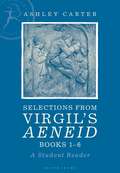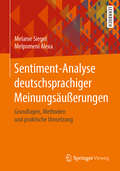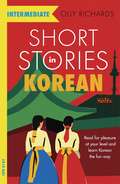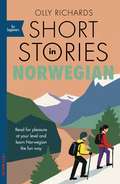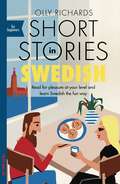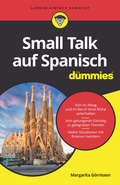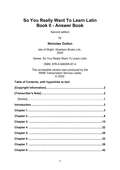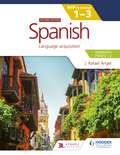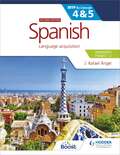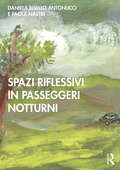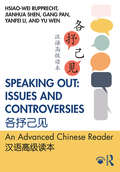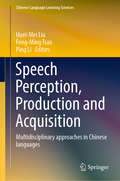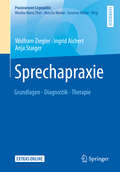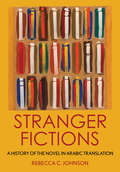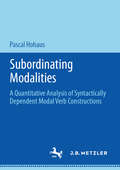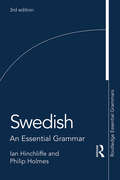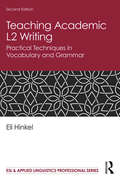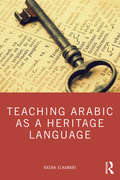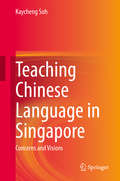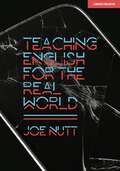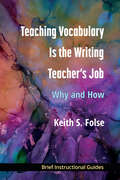- Table View
- List View
Selections from Virgil's Aeneid Books 1-6: A Student Reader
by Ashley CarterThis reader of Virgil's text features passages from the first half of the Aeneid and is designed to help students understand and appreciate Virgil's poem, as well as improve their Latin reading skills. Each Latin passage is accompanied by running vocabulary, on-page commentary notes and targeted questions. The book can be used as a source of one-off unseen passages or as a reader for students working through individual books or the whole poem. The commentary notes explain references to characters, places and events, provide linguistic and grammatical help on more challenging Latin phrases, and point out stylistic features. The questions test students' comprehension of the characters and storyline, and give them practice in handling literary terms. The passages are linked by summaries of the continuing plot, so students can grasp the progression of the poem as a whole. An in-depth introduction sets the story of the Aeneid in its mythological, literary and historical contexts; a glossary of literary devices and sections on style and metre are included. At the end of the book is a complete alphabetical vocabulary list.
Sentiment-Analyse deutschsprachiger Meinungsäußerungen: Grundlagen, Methoden und praktische Umsetzung
by Melanie Siegel Melpomeni AlexaDer Zugang zu Information ist durch das Internet erheblich verändert und erleichtert worden. Gleichzeitig gibt es seit dem Web 2.0 die Möglichkeit für alle Internet-Nutzer, selbst Inhalte beizusteuern, indem sie in Foren schreiben, oder Twitter, Xing, LinkedIn, Facebook oder andere soziale Medien nutzen und auf veröffentliche Posts z. B. durch Kommentare reagieren. Diese Fülle an Informationen und Meinungen ist ein wertvoller und in der Regel sehr großer Datenschatz, den man nur mit automatischen Verfahren sinnvoll nutzen kann.Die automatische Analyse von Meinungsäußerungen gehört in die Anwendungsbereiche Informationsextraktion und Inhaltsanalyse sowie Text Mining. Aus Texten von Internet-Nutzern werden Informationen extrahiert und analysiert, wie sie sich zu bestimmten Themen, Produkten oder Ereignissen äußern.Dieses Buch gibt eine systematische Einführung in Methoden der automatischen Analyse von Meinungsäußerungen und zeigt die Anwendung der beschriebenen Methoden in Programmierübungen. Der Fokus liegt dabei auf deutschsprachige Daten, also auf linguistischen Ressourcen sowie Methoden zur automatischen Analyse für die deutsche Sprache. Viele Übungsaufgaben sowie in Python implementierte Programmierbeispiele und -aufgaben machen das Buch zum optimalen Begleiter für Studium und Selbststudium.
Short Stories in Korean for Intermediate Learners: Read for pleasure at your level, expand your vocabulary and learn Korean the fun way! (Foreign Language Graded Reader Series)
by Olly RichardsAn unmissable collection of eight unconventional and captivating short stories for young adult and adult intermediate learners of Korean."Olly's top-notch language-learning insights are right in line with the best of what we know from neuroscience and cognitive psychology about how to learn effectively. I love his work - and you will too!" - Barbara Oakley, PhD, Author of New York Times bestseller A Mind for Numbers Short Stories in Korean for Intermediate Learners has been written especially for students from low-mid intermediate (ACTFL) level of Korean. Mapped to B1 and approaching B2 on the Common European Framework of Reference, these eight captivating stories are designed to give you a sense of achievement and a feeling of progress when reading, and most importantly - enjoyment!What does this book give you?- Eight stories in a variety of exciting genres, from science fiction and crime to history and thriller - making reading fun, while you learn a wide range of new vocabulary- Controlled language at your level, including the 1000 most frequent words, to help you progress confidently- Authentic spoken dialogues, to help you learn conversational expressions and improve your speaking ability- Accessible grammar so you learn new structures naturally, in a stress-free way- Beautiful illustrations accompanying each story, to set the scene and support your understanding- Pleasure! Research shows that if you're enjoying reading in a foreign language, you won't experience the usual feelings of frustration - 'It's too hard!' 'I don't understand!'With intriguing plots that will spark your imagination and keep you reading, Short Stories in Korean for Intermediate Learners will take your grasp of Korean to the next level with key features to support and consolidate your progress, including: -A glossary for bolded words in each text -Full plot summary-A bilingual word list-Comprehension questions after each chapter. As a result, you will be able to focus on enjoying reading, delighting in your improved range of vocabulary and grasp of the language, without ever feeling overwhelmed or frustrated. From science fiction to fantasy, to crime and thrillers, Short Stories in Korean for Intermediate Learners uses reading as the perfect tool to not only delight in learning Korean, but to accelerate your journey towards fluency.Use the codes inside the book and ebook to access a bonus story for free and the discounted audiobook on our Language Readers Library site or in the Language Readers app.
Short Stories in Norwegian for Beginners: Read for pleasure at your level, expand your vocabulary and learn Norwegian the fun way! (Foreign Language Graded Reader Series)
by Olly RichardsAn unmissable collection of eight unconventional and captivating short stories for young and adult learners of Norwegian."Olly's top-notch language-learning insights are right in line with the best of what we know from neuroscience and cognitive psychology about how to learn effectively. I love his work - and you will too!" - Barbara Oakley, PhD, Author of New York Times bestseller A Mind for Numbers Short Stories in Norwegian for Beginners has been written especially for students from high-beginner to low-intermediate level, designed to give a sense of achievement, a feeling of progress and most importantly - enjoyment! Mapped to A2-B1 on the Common European Framework of Reference (CEFR) for languages, these eight captivating stories are designed to give you a sense of achievement and a feeling of progress when reading.What does this book give you?- Eight stories in a variety of exciting genres, from science fiction and crime to history and thriller - making reading fun, while you learn a wide range of new vocabulary-Controlled language at your level to help you progress confidently-Authentic spoken dialogues to help you learn conversational expressions and improve your speaking ability-Accessible grammar so you learn new structures naturally, in a stress-free way-Pleasure! Research shows that if you're enjoying reading in a foreign language, you won't experience the usual feelings of frustration - 'It's too hard!' 'I don't understand!'Carefully curated to make learning a new language easy, these stories include key features that will support and consolidate your progress, including: - A glossary for bolded words in each chapter- Full plot summary- A bilingual word list- Comprehension questions after each chapter. As a result, you will be able to focus on enjoying reading, delighting in your improved range of vocabulary and grasp of the language, without ever feeling overwhelmed. From science fiction to fantasy, to crime and thrillers, Short Stories in Norwegian for Beginners will make learning Norwegian easy and enjoyable.
Short Stories in Swedish for Beginners: Read for pleasure at your level, expand your vocabulary and learn Swedish the fun way! (Foreign Language Graded Reader Series)
by Olly RichardsAn unmissable collection of eight unconventional and captivating short stories for young and adult learners of Swedish."Olly's top-notch language-learning insights are right in line with the best of what we know from neuroscience and cognitive psychology about how to learn effectively. I love his work - and you will too!" - Barbara Oakley, PhD, Author of New York Times bestseller A Mind for Numbers Short Stories in Swedish for Beginners has been written especially for students from high-beginner to low-intermediate level, designed to give a sense of achievement, a feeling of progress and most importantly - enjoyment! Mapped to A1-B1 on the Common European Framework of Reference (CEFR) for languages, these eight captivating stories are designed to give you a sense of achievement and a feeling of progress when reading.What does this book give you?- Eight stories in a variety of exciting genres, from science fiction and crime to history and thriller - making reading fun, while you learn a wide range of new vocabulary- Controlled language at your level to help you progress confidently- Realistic spoken dialogues to help you learn conversational expressions and improve your speaking ability- Accessible grammar so you learn new structures naturally, in a stress-free way- Pleasure! Research shows that if you're enjoying reading in a foreign language, you won't experience the usual feelings of frustration - 'It's too hard!' 'I don't understand!'Carefully curated to make learning a new language easy, these stories include key features that will support and consolidate your progress, including: - A glossary for bolded words in each chapter- Full plot summary- A bilingual word list- Comprehension questions after each chapter. As a result, you will be able to focus on enjoying reading, delighting in your improved range of vocabulary and grasp of the language, without ever feeling overwhelmed. From science fiction to fantasy, to crime and thrillers, Short Stories in Swedish for Beginners will make learning Swedish easy and enjoyable.
Small Talk auf Spanisch für Dummies (Für Dummies)
by Margarita GörrissenBei Tapas und einem guten Rioja entspannt ins Gespräch kommen? Im Beruf durch nette Plauderei eine entspannte Atmosphäre schaffen? Bei einer Einladung die richtigen Begrüßungsworte finden? Mit diesem Buch gelingt es Ihnen! Lernen Sie spanische Vokabeln und Redewendungen für den Small Talk kennen. Erfahren Sie, welche Themen in Spanien oder Lateinamerika small-talk-tauglich sind und welche nicht. Lassen Sie sich Techniken zeigen, mit denen Sie ein Gespräch beginnen, aufrechterhalten und beenden. Und haben Sie vor allem eines: jede Menge Spaß beim Small Talk!
So You Really Want To Learn Latin Book II Answer Book (So You Really Want To Learn Latin)
by N.R.R. OultonSpanish for the IB MYP 1-3 (Emergent/Phases 1-2) (Emergent/Phases 1-2) (Emergent/Phases 1-2) (Emergent/Phases 1-2): MYP by Concept Second edition: By Concept
by J. Rafael AngelDevelop your skills to become an inquiring learner; ensure you navigate the MYP framework with confidence using a concept-driven and assessment-focused approach to Spanish, presented in global contexts.- Develop conceptual understanding with key MYP concepts and related concepts at the heart of each chapter. - Learn by asking questions for a statement of inquiry in each chapter. - Prepare for every aspect of assessment using support and tasks designed by experienced educators.- Understand how to extend your learning through research projects and interdisciplinary opportunities.- Think internationally with chapters and concepts set in global contexts.
Spanish for the IB MYP 4&5 (Emergent/Phases 1-2) (Emergent/Phases 1-2) (Emergent/Phases 1-2) (Emergent/Phases 1-2): MYP by Concept Second edition: By Concept
by J. Rafael AngelDevelop your skills to become an inquiring learner; ensure you navigate the MYP framework with confidence using a concept-driven and assessment-focused approach to Spanish, presented in global contexts.- Develop conceptual understanding with key MYP concepts and related concepts at the heart of each chapter. - Learn by asking questions for a statement of inquiry in each chapter. - Prepare for every aspect of assessment using support and tasks designed by experienced educators.- Understand how to extend your learning through research projects and interdisciplinary opportunities.- Think internationally with chapters and concepts set in global contexts.
Spazi Riflessivi in Passeggeri Notturni
by Daniela Bisello Antonucci Paola NastriSpazi Riflessivi in Passeggeri Notturni è un testo innovativo e versatile per l’insegnamento dell’italiano tramite riflessioni ed elaborazioni su questioni sociali emerse dalla lettura di Passeggeri notturni, racconti brevi di Gianrico Carofiglio. Il testo, indicato per un livello intermedio-avanzato, propone una vasta gamma di esercizi grammaticali contestualizzati e attività interdisciplinari che confrontano letterature e arti diverse e affrontano discussioni socio-culturali.
Spazi Riflessivi in Passeggeri Notturni
by Daniela Bisello Antonucci Paola NastriSpazi Riflessivi in Passeggeri Notturni è un testo innovativo e versatile per l’insegnamento dell’italiano tramite riflessioni ed elaborazioni su questioni sociali emerse dalla lettura di Passeggeri notturni, racconti brevi di Gianrico Carofiglio. Il testo, indicato per un livello intermedio-avanzato, propone una vasta gamma di esercizi grammaticali contestualizzati e attività interdisciplinari che confrontano letterature e arti diverse e affrontano discussioni socio-culturali.
Speaking Out: An Advanced Chinese Reader 汉语高级读本
by Hsiao-wei Rupprecht Jianhua Shen Gang Pan Yanfei Li Yu WenSpeaking Out: Issues and Controversies 各抒己见 is an advanced Chinese language textbook that explores topics such as human nature, moral values, mass consumption, Western influences, and technological innovation. In presenting subjects that reflect major concerns in contemporary China, the book invites students to reflect upon the forces shaping modern Chinese society. This textbook presents ten lessons in five units entitled "Constancy and Change," "Joy and Sorrow," "Right and Wrong," "Chinese Tradition and Western Influence," and "New and Old." These pairs of opposites conjure up an ever-changing world of ebb and flow, a world that stimulates learners’ imaginations and arouses their enthusiasm for open dialogue and lively discussion. Concise in language and with lessons in both simplified and traditional characters, the textbook is a valuable aid for university students interested in passing the HSK Level VI or attaining ACTFL advanced-level proficiency. Accompanying audio recordings can be found online at www.routledge.com/9780367902704.
Speaking Out: An Advanced Chinese Reader 汉语高级读本
by Hsiao-wei Rupprecht Jianhua Shen Gang Pan Yanfei Li Yu WenSpeaking Out: Issues and Controversies 各抒己见 is an advanced Chinese language textbook that explores topics such as human nature, moral values, mass consumption, Western influences, and technological innovation. In presenting subjects that reflect major concerns in contemporary China, the book invites students to reflect upon the forces shaping modern Chinese society. This textbook presents ten lessons in five units entitled "Constancy and Change," "Joy and Sorrow," "Right and Wrong," "Chinese Tradition and Western Influence," and "New and Old." These pairs of opposites conjure up an ever-changing world of ebb and flow, a world that stimulates learners’ imaginations and arouses their enthusiasm for open dialogue and lively discussion. Concise in language and with lessons in both simplified and traditional characters, the textbook is a valuable aid for university students interested in passing the HSK Level VI or attaining ACTFL advanced-level proficiency. Accompanying audio recordings can be found online at www.routledge.com/9780367902704.
Speech Perception, Production and Acquisition: Multidisciplinary approaches in Chinese languages (Chinese Language Learning Sciences)
by Huei‐Mei Liu Feng‐Ming Tsao Ping LiThis book addresses important issues of speech processing and language learning in Chinese. It highlights perception and production of speech in healthy and clinical populations and in children and adults. This book provides diverse perspectives and reviews of cutting-edge research in past decades on how Chinese speech is processed and learned. Along with each chapter, future research directions have been discussed. With these unique features and the broad coverage of topics, this book appeals to not only scholars and students who study speech perception in preverbal infants and in children and adults learning Chinese, but also to teachers with interests in pedagogical applications in teaching Chinese as Second Language.
Sprechapraxie: Grundlagen - Diagnostik - Therapie (Praxiswissen Logopädie)
by Wolfram Ziegler Ingrid Aichert Anja StaigerDieses Buch aus der Reihe Praxiswissen Logopädie ist ein Brückenschlag zwischen Theorie und Praxis. Umfassendes Grundlagenwissen zur Sprechapraxie wird ergänzt durch:Hilfestellungen für die differenzialdiagnostische Abgrenzung, eine anschauliche Darstellung diagnostischer Möglichkeiten, eine umfangreiche Übersicht und kritische Reflexion bekannter Therapieansätze, Therapiebausteine und Orientierungshilfen für die Entwicklung individueller Behandlungskonzepte. Mit zahlreichen Abbildungen, praxisorientierten Tipps, weiterführende Literaturhinweise und Internetlinks sowie ein Anamnesebogen zum DownloadRenommierte Autoren transportieren verständlich und praxisnah ihr Wissen und ihre Erfahrungen mit diesem komplexen Krankheitsbild. Sie rüsten den Leser für eine gut begründete und effiziente Arbeit mit dem Patienten.
Stranger Fictions: A History of the Novel in Arabic Translation
by Rebecca C. JohnsonZaynab, first published in 1913, is widely cited as the first Arabic novel, yet the previous eight decades saw hundreds of novels translated into Arabic from English and French. This vast literary corpus influenced generations of Arab writers but has, until now, been considered a curious footnote in the genre's history. Incorporating these works into the history of the Arabic novel, Stranger Fictions offers a transformative new account of modern Arabic literature, world literature, and the novel.Rebecca C. Johnson rewrites the history of the global circulation of the novel by moving Arabic literature from the margins of comparative literature to its center. Considering the wide range of nineteenth- and early twentieth-century translation practices—including "bad" translation, mistranslation, and pseudotranslation—Johnson argues that Arabic translators did far more than copy European works; they authored new versions of them, producing sophisticated theorizations of the genre. These translations and the reading practices they precipitated form the conceptual and practical foundations of Arab literary modernity, necessitating an overhaul of our notions of translation, cultural exchange, and the global.Examining nearly a century of translations published in Beirut, Cairo, Malta, Paris, London, and New York, from Qiat Rūbinun Kurūzī (The story of Robinson Crusoe) in 1835 to pastiched crime stories in early twentieth-century Egyptian magazines, Johnson shows how translators theorized the Arab world not as Europe's periphery but as an alternative center in a globalized network. Stranger Fictions affirms the central place of (mis)translation in both the history of the novel in Arabic and the novel as a transnational form itself.
Subordinating Modalities: A Quantitative Analysis of Syntactically Dependent Modal Verb Constructions
by Pascal HohausThis study is concerned with the use of the English modals (may, might, can, could, shall, should, will, would and must) in adverbial, relative complement clauses. It employs synchronic data from the British National Corpus and quantitative methods to investigate similarities and differences between the core modals, as well as modal-specific preferences in subordinate clauses. The main finding is that modal verbs in subordinate clauses may be conceived of as meso-constructions and that they qualify as micro-constructions once further syntagmatic features are considered. This allows for distinguishing modal verb phrases with different degrees of complexity, schematicity, productivity and subjectivity. Further applications give us insights into collocations, modal harmony, semantic preference, and the attraction of dynamic meaning to relative clauses.
Swedish: An Essential Grammar (Routledge Essential Grammars)
by Ian Hinchliffe Philip HolmesThis fully revised third edition of Swedish: An Essential Grammar incorporates changes proposed to Swedish grammar by Svenska Akademiens grammatik. Examples have been fully updated and the bibliography has been expanded. Swedish: An Essential Grammar provides a fresh and accessible description of the language. Explanations are free of jargon and emphasis has been placed on areas of Swedish that pose a particular challenge for English-speaking learners. The book offers: • a clear, accessible format; • authentic examples of language use, taken from a range of media; • clear, jargon-free explanations of grammar. Suitable for independent study or for class-based tuition, Swedish: An Essential Grammar continues to be an invaluable source to all learners looking to improve their knowledge of Swedish grammar.
Teaching Academic L2 Writing: Practical Techniques in Vocabulary and Grammar (ESL & Applied Linguistics Professional Series)
by Eli HinkelThe new edition of this comprehensive text fills an important role in teacher professional preparation by focusing on how to teach the grammar and vocabulary that are essential for all L2 writing teachers and student-writers. Before L2 writers can begin to successfully produce academic prose, they need to understand the foundations of the language and develop the language tools that will help them build reasonable quality text. Targeting specific problem areas of students’ writing, this text offers a wealth of techniques for teaching writing, grammar, and vocabulary to second-language learners. Updated with current research and recent corpus analysis findings, the second edition features a wealth of new materials, including new teaching activities; student exercises and assignments; and substantially revised appendices with supplementary word and phrase lists and sentence components. Designed for preservice ESL/ELT/TESOL courses as well as Academic Writing and Applied Linguistics courses, this book includes new, contextualized examples in a more accessible and easy-to-digest format.
Teaching Academic L2 Writing: Practical Techniques in Vocabulary and Grammar (ESL & Applied Linguistics Professional Series)
by Eli HinkelThe new edition of this comprehensive text fills an important role in teacher professional preparation by focusing on how to teach the grammar and vocabulary that are essential for all L2 writing teachers and student-writers. Before L2 writers can begin to successfully produce academic prose, they need to understand the foundations of the language and develop the language tools that will help them build reasonable quality text. Targeting specific problem areas of students’ writing, this text offers a wealth of techniques for teaching writing, grammar, and vocabulary to second-language learners. Updated with current research and recent corpus analysis findings, the second edition features a wealth of new materials, including new teaching activities; student exercises and assignments; and substantially revised appendices with supplementary word and phrase lists and sentence components. Designed for preservice ESL/ELT/TESOL courses as well as Academic Writing and Applied Linguistics courses, this book includes new, contextualized examples in a more accessible and easy-to-digest format.
Teaching Arabic as a Heritage Language
by Rasha ElHawariTeaching Arabic as a Heritage Language is a practical guide to Arabic pedagogy for Heritage Learners of Arabic. Exploring the teaching of Arabic as a foreign language (TAFL) in North America and Europe, it covers sociocultural topics such as diglossia and religion alongside theoretical approaches to Heritage Language Learning. It also provides a new and detailed definition of the heritage language learner (HLL) of Arabic. The role of the professor and the material are explored to ensure a successful learning experience. The latest advances in HLL are considered together with the recent and recommended changes in classroom practice, giving rise to the recognition of the individual needs of heritage learners. This is an indispensable resource for instructors, researchers, and students in the fields of TAFL and TASOL, as well as linguists interested in Arabic language learning and teaching.
Teaching Arabic as a Heritage Language
by Rasha ElHawariTeaching Arabic as a Heritage Language is a practical guide to Arabic pedagogy for Heritage Learners of Arabic. Exploring the teaching of Arabic as a foreign language (TAFL) in North America and Europe, it covers sociocultural topics such as diglossia and religion alongside theoretical approaches to Heritage Language Learning. It also provides a new and detailed definition of the heritage language learner (HLL) of Arabic. The role of the professor and the material are explored to ensure a successful learning experience. The latest advances in HLL are considered together with the recent and recommended changes in classroom practice, giving rise to the recognition of the individual needs of heritage learners. This is an indispensable resource for instructors, researchers, and students in the fields of TAFL and TASOL, as well as linguists interested in Arabic language learning and teaching.
Teaching Chinese Language in Singapore: Concerns and Visions
by Kaycheng SohThis book addresses the problems and issues surrounding teaching Chinese as a second language in the Singapore context. It identifies four main areas of concern: (1) Neglect of culture in the teaching of Chinese; (2) Difficulty of learning Hanzi (Chinese characters); (3) Cognitive and affective aspects of Chinese language learning; and (4) Authenticity of the Chinese language in a global and Singapore context. The book includes lesson design and instructional practices for re-prioritizing Chinese as a set of trainable skills, as well as teaching culture in the context of teaching the language. It also introduces the Chinese as a Second Language Readability Formula to help learners overcome their difficulties with learning Hanzi (Chinese characters), and the Attitude Toward Chinese Language Scale to help understand the various factors that can influence Chinese language learning. It also proposes a student-oriented model for conducting problem-based research, tapping into the disciplines of psycholinguistics and sociolinguistics.Resolving or minimizing the issues identified here requires action at the macro level by Chinese language researchers on a national scale, and at the micro level by classroom teachers through action research.
Teaching English for the Real World
by Joe NuttSo much of the teaching in schools of how the English works does not prepare students for the real world. So little has changed in exams, the curriculum, or the way people think about English teaching, in several decades. This book is Joe Nutt's attempt to help schools redress that dramatic imbalance. It's not in any sense a practical teaching guide only for English teachers, nor is it full of hints and tips, lesson plans and schemes of work. Teaching English for the Real World is a far wider consideration of what schools and English teachers should be doing if they wish to prepare secondary school children to be successful and effective users of English, in the real world of work, higher education and adult life they will all too soon enter. If you are an English teacher, by the time you finish reading Teaching English for the Real World, you should be better prepared to deliver lessons that those you teach will forever be grateful for. The book consists of four main sections: English in context, towards the GCSE, choosing texts and technology matters. It starts by putting English clearly into context through a range of current examples. It urges teachers to consider the complex role English usage plays on everything from the side of a bus, through tissue-thin social media, garish slideshows and perky TED talks, to the hundreds of pages of research or official reports so often used as the basis for serious political policy and commercial decision making. It will then examine the classroom status quo and instead of the unrealistic and damaging focus on experiment and creativity, instead of requiring them to write newspaper articles, stories or speeches, the main deliverables in any English GCSE exam, the book will argue that teachers should think carefully about how to connect what children write, with who they are and where they really want to publish. The next section deals with choices of texts. There is a place for children to be taught to write well by example, but there are challenging questions to ask about much of the material routinely chosen. How often are texts and authors selected for study, for reasons that have absolutely nothing whatsoever to do with knowledge or linguistic skill, and everything to do with politics? Even exam boards are guilty of this. The final section examines the relationship between English and the technology real people use to produce it. It reflects on how technology has impacted on the quality of the reading experience itself and argue that there is a crisis in reading in secondary schools, with many children sailing through exams yet leaving school as disinterested and even poor readers. And it suggests how teachers might approach introducing these different risks to children and equip them best to make sound judgements about the way they write and communicate, for personal and employment purposes in adult life.
Teaching Vocabulary Is the Writing Teacher's Job: Why and How
by Keith S. FolseWhile most teachers acknowledge the importance of vocabulary in learning a new language, many assume a reading class or other teacher will cover vocabulary. Yet vocabulary plays an essential role in good writing, especially academic writing. Teaching Vocabulary Is the Writing Teacher’s Job explores the serious nature of ESL students’ lexical plight and looks at vocabulary in relation to reading, speaking, listening, and writing proficiency. It also examines the role of vocabulary in ESL writing assessment. In the conclusion, author Keith Folse discusses eight research-based suggestions for writing teachers, including encouraging students to become vocabulary detectives, teaching collocations, testing vocabulary, and teaching paraphrasing and summarizing.
